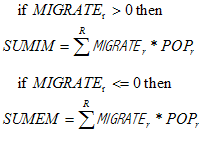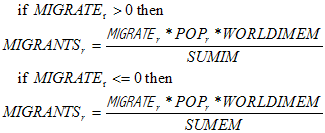Migration is treated with a pooled approach. It is driven by an exogenous parameter (migrater) specifying the net percentage of the population migrating each year (negative values indicate immigration and positive values indicate emigration). The first step is to swap that value into an internal model calculation of the migration rate (MIGRATE).
![]()
The full global set of migration rates is unlikely, however, to provide a balanced global total of immigrants and emigrants. The next step is thus to calculate those totals, even though they are likely to be unequal.

After calculation of the world sums of immigrants and emigrants, the total world migration is assumed to be the average of the two. Then that total world migration is imposed on net immigrant and net emigrant regions through normalization.
![]()

Although the above equation assures that the global sum of migrants will be zero (immigration equals emigration), it is important to recompute the actual migration rate, so that it represents the true inflow or outflow of migrants after that balancing. Note that the computed migration rates (MIGRATE) will almost certainly be a bit different from the input parameter (migrater).
![]()